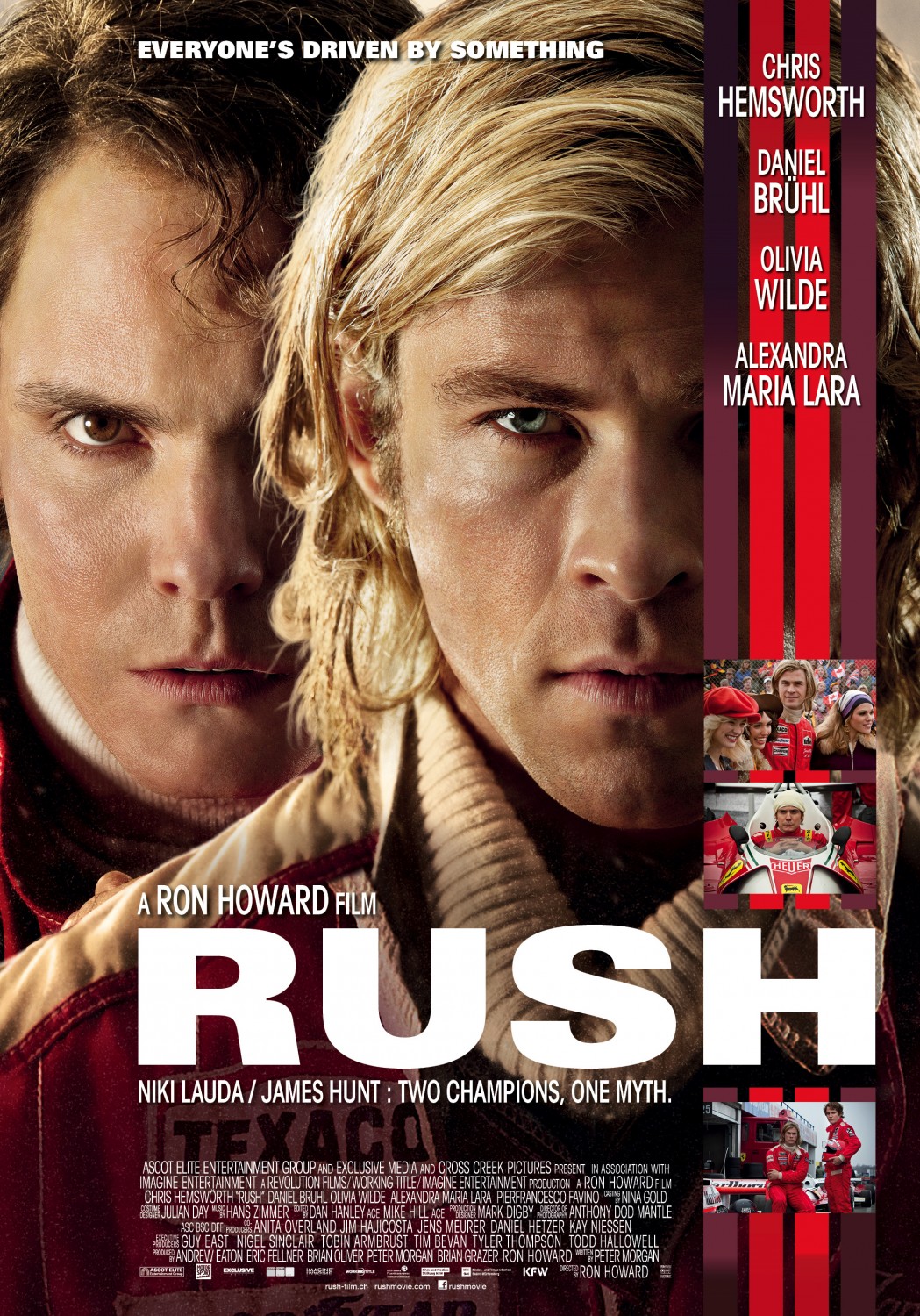
The movie Rush brings viewers the tension and excitement of Niki Lauda and James Hunt’s Formula 1 rivalry while maintaining factual accuracy. Lauda is methodical and focused in contrast to Hunt who is a brash playboy. However, both men face difficulties in their own right while fighting to become the world champion. Their hardships result in a pair of characters you both want to succeed.
Analyzing Rush reveals patterns in Ron Howard’s directorial approach. Any scene where the camera is far away from the subject tends to have the subject brighter than its surroundings. The photo bellow is clearly highlighting the bright red car closest to us, despite the dark, rainy day.

The scene below shows an interview with Niki Lauda about his return to racing after a large accident
Opening with a wide angle, out of focus shot relates to Niki’s current mental and physical state. Panning the room tells us the press conference is very large. Tight shots surrounding Lauda and focusing on his name card help tell us this is a live broadcast and the conference is all about Niki. Characters who do not show much emotion (such as the reporters) are framed loosely. Emotions are captured up close with the character taking up nearly the entire screen and help us connect on a personal level. Pacing in this scene is slow, and deliberate. Which increasing the impact of Niki’s return to racing. At the end of the scene the pace increases and the camera gets shaky, moving with James Hunt as he fights a reporter.
Colors and lighting are in play as well. This scene is dull and not particularly bright, adding to the nervous feeling as Niki returns to racing after the crash. The reporters are bellow, and dimly lit. While Niki is above them at a table with some sunlight on him, making hime the center of the scene.
The start of the final race of the season
Music through the movie also follows patterns. Blown out, bass heavy beats are used to represent heartbeats, or build to a crescendo as the action intensifies. Strings are used to display the severity of a scene. The final race, which is ran in excessively dangerous conditions opens with slow deep music as people using black umbrealas walk around the cars. The music and color of the scene make it feel like a funeral. Making it stressful to watch. The music is only broken by the sound of heavy rain, revving engines, and the low rumble of the spectators.
While this scene shows the drivers already wearing helmets, the emotions captured is unbelievable. As the two rivals uncharacteristically wave to one another, you begin to feel sure one will not survive this race. The crowd also acted differently, there was a scared tension in the air captured by slow movements and wide dark shots focusing on small movements like the cars quivering on the start line.
The starting sequence happens very slowly and deliberately. The man starting the race was framed tightly, showing fear. While the cars slowly moved from the start. Shaky cameras and slowing of time made the scene fee surreal.
By the end of Rush you have learned so much of Hunt and Lauda that you want them each to succeed. The antagonist of the film seems to come in the form of death. While not a specific character it begins to loom over the film as the story progresses. With the final race scene the audience shifts from being concerned about who will win, but who might die
Some time after watching Rush I was still struggling with a making sense of a cultural analysis of the movie. Unlike most stories it doesn’t have a clear protagonist, and antagonist. It is more of a dramatized reenactment of the real rivalry which took place between Hunt and Lauda. I found it to be more more relatable to everyday competition and rivalry. In our daily lives there is seldom a true antagonist who we are in a drawn in battle against. Usually people we struggle to get along with are more similar to us than we would like to think.
Rush feels incredibly real as you watch. You feel like you are there the whole time as you become invested in the characters. The framing of the characters faces shows so much emotion. Ron Howard uses this emotional attachment to his advantage near the end of the movie where the viewers truly fear for the wellbeing of Hunt and Lauda.
If you are interested in the film here is a interview with Niki Lauda about the film.
Sources:
Start of final race https://www.youtube.com/watch?v=6C4G-NvsAF0
movie poster https://cloudpix.co/dvd-cover-movie-poster-rush-706688.html
Cars on grid http://media.cdn.mclaren.com/images/galleries/8D92_D009_00042_R_DRDTqvU.jpg
The ILM is one of those lower-priced helmets, that will give the prospective buyer Encouraged in proceedings. At the same time as it comes weighed down with some great features, the fact that it is available at a lower price compared to rival full-face helmets gives buyers the feeling that the helmet may not be on equivalence with its competitors.
https://oursafetysecurity.com/ilm-helmet-review/